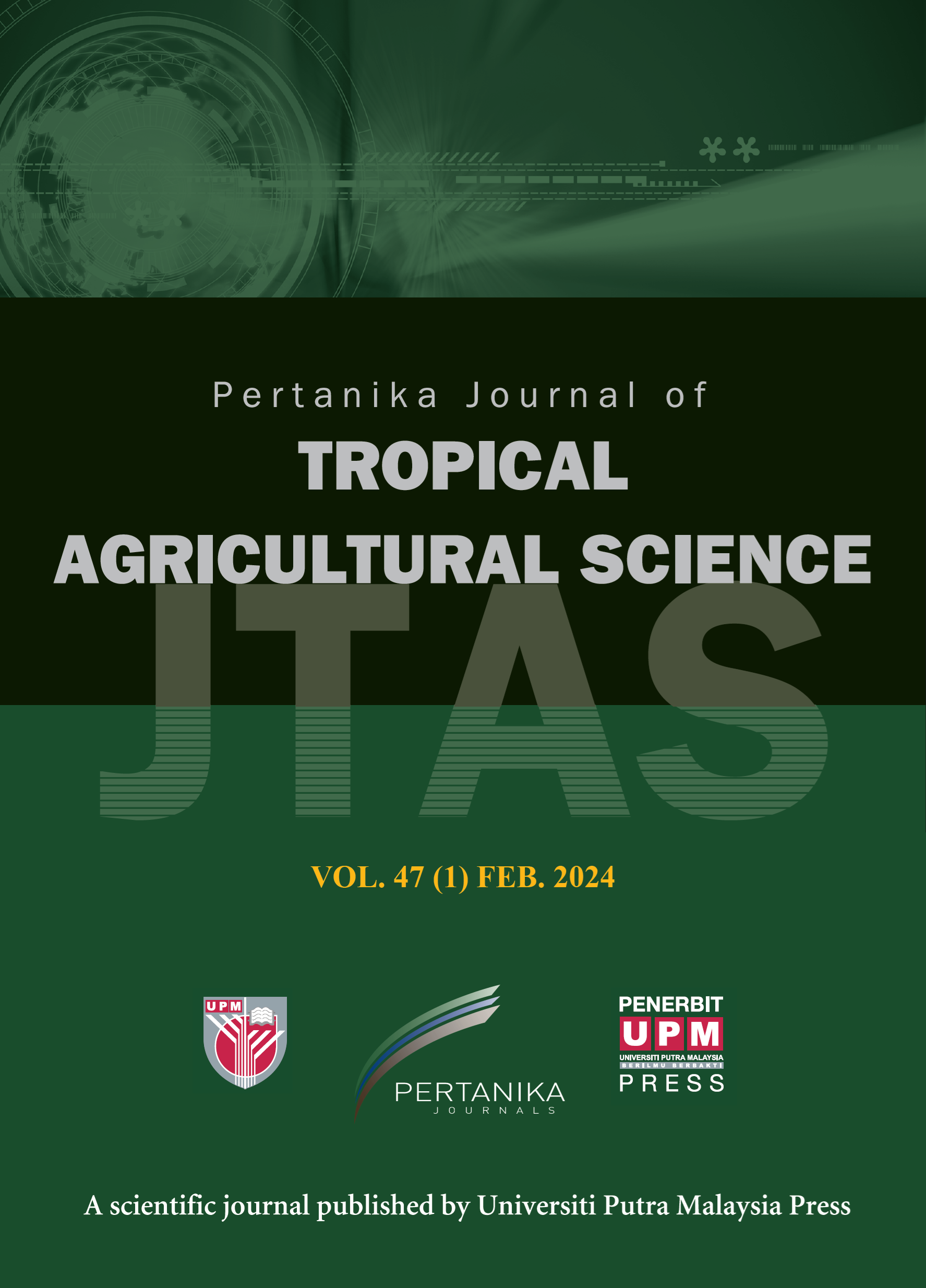PERTANIKA JOURNAL OF TROPICAL AGRICULTURAL SCIENCE
e-ISSN 2231-8542
ISSN 1511-3701
J
J
Pertanika Journal of Tropical Agricultural Science, Volume J, Issue J, January J
Keywords: J
Published on: J
J
-
Alias, S. N., Hamid, N. Z. A., Saleh, S. H. M., & Bidin, B. (2021). Predicting carbon monoxide time series between different settlements area in Malaysia through chaotic approach. Journal of Science and Mathematics Letters, 9, 45-54. https://doi.org/https://doi.org/10.37134/jsml.vol9.sp.6.2021
-
Alpan, K., & Sekeroglu, B. (2020). Prediction of pollutant concentrations by meteorological data using machine learning algorithms. International Archives of the Photogrammetry, Remote Sensing and Spatial Information Sciences - ISPRS Archives, 44(4/W3), 21-27. https://doi.org/10.5194/isprs-archives-XLIV-4-W3-2020-21-2020
-
Arabameri, A., Pradhan, B., & Lombardo, L. (2019). Comparative assessment using boosted regression trees, binary logistic regression, frequency ratio and numerical risk factor for gully erosion susceptibility modelling. Catena, 183(6), Article 104223. https://doi.org/10.1016/j.catena.2019.104223
-
Arhami, M., Kamali, N., & Rajabi, M. M. (2013). Predicting hourly air pollutant levels using artificial neural networks coupled with uncertainty analysis by Monte Carlo simulations. Environmental Science and Pollution Research, 20(7), 4777-4789. https://doi.org/10.1007/s11356-012-1451-6
-
Breiman, L., Culter, A., Liaw, A., & Wiener, M. (2002). Classification and regression by random forest. R News, 2, 18-22.
-
Cai, M., Yin, Y., & Xie, M. (2009). Prediction of hourly air pollutant concentrations near urban arterials using artificial neural network approach. Transportation Research Part D: Transport and Environment, 14(1), 32-41. https://doi.org/10.1016/j.trd.2008.10.004
-
Dedovic, M. M., Avdakovic, S., Turkovic, I., Dautbasic, N., & Konjic, T. (2016). Forecasting PM10 concentrations using neural networks and system for improving air quality. In 2016 xi international symposium on telecommunications (bihtel) (pp. 1-6). IEEE Publishing. https://doi.org/10.1109/BIHTEL.2016.7775721
-
Department of Environment. (1997). A guide to air pollution index in Malaysia (API). Ministry of Science, Technology and the Environment. https://aqicn.org/images/aqi-scales/malaysia-api-guide.pdf
-
Department of Environment. (2017). AIR pollutant index (API) calculation. Ministry of Environment and Water. http://apims.doe.gov.my/public_v2/pdf/API_Calculation.pdf
-
Elith, J., Leathwick, J. R., & Hastie, T. (2008). A working guide to boosted regression trees. Journal of Animal Ecology, 77(4), 802-813. https://doi.org/10.1111/j.1365-2656.2008.01390.x
-
Hamid, H. A., Japeri, A. Z. U. S. M., & Ahmat, H. (2017). Characteristic and prediction of carbon monoxide concentration using time series analysis in selected urban area in Malaysia. In MATEC Web of Conferences (Vol. 103, p. 05001). EDP Sciences.. https://doi.org/10.1051/matecconf/201710305001
-
Hu, Y., Scavia, D., & Kerkez, B. (2018). Are all data useful? Inferring causality to predict flows across sewer and drainage systems using directed information and boosted regression trees. Water Research, 145, 697-706.
-
Lu, J., Zhang, Y., Chen, M., Wang, L., Zhao, S., Pu, X., & Chen, X. (2021). Estimation of monthly 1 km resolution PM2.5 concentrations using a random forest model over “2 + 26” cities, China. Urban Climate, 35, Article 100734. https://doi.org/10.1016/j.uclim.2020.100734
-
Masih, A. (2019). Application of random forest algorithm to predict the atmospheric concentration of NO2. In 2019 Ural Symposium on Biomedical Engineering, Radioelectronics and Information Technology (USBEREIT) (pp. 252-255). AIP Publishing LLC. https://doi.org/10.1063/1.5137947
-
Moazami, S., Noori, R., Amiri, B. J., Yeganeh, B., Partani, S., & Safavi, S. (2016). Reliable prediction of carbon monoxide using developed support vector machine. Atmospheric Pollution Research, 7(3), 412-418. https://doi.org/10.1016/j.apr.2015.10.022
-
Moustris, K. P., Ziomas, I. C., & Paliatsos, A. G. (2010). 3-day-ahead forecasting of regional pollution index for the pollutants NO2, CO, SO2, and O3 using artificial neural networks in athens, Greece. Water, Air, and Soil Pollution, 209(1-4), 29-43. https://doi.org/10.1007/s11270-009-0179-5
-
Qadeer, K., & Jeon, M. (2019). Prediction of PM10 concentration in South Korea using gradient tree boosting models. In PervasiveHealth: Pervasive Computing Technologies for Healthcare (pp. 1-6). ACM Publishing. https://doi.org/10.1145/3387168.3387234
-
Rahman, N. H. A., Lee, M. H., Latif, M. T., & Suhartono, S. (2013). Forecasting of air pollution index with artificial neural network. Jurnal Teknologi, 63(2), 59-64. https://doi.org/10.11113/jt.v63.1913
-
Sekar, C., Gurjar, B. R., Ojha, C. S. P., & Goyal, M. K. (2016). Potential assessment of neural network and decision tree algorithms for forecasting ambient PM2.5 and CO concentrations: Case study. Journal of Hazardous, Toxic, and Radioactive Waste, 20(4), 1-9. https://doi.org/10.1061/(asce)hz.2153-5515.0000276
-
Shaadan, N., Rusdi, M. S., Azmi, N. N. S. N. M., Talib, S. F., & Azmi, W. A. W. (2019). Time series model for Carbon Monoxide (CO) at several industrial sites in Peninsular Malaysia. Malaysian Journal of Computing (MJoC), 4(1), 246-260.
-
Shaharuddin, A., & Noorazuan, M. H. (2006). Kebakaran hutan dan isu pencemaran udara di Malaysia: Kes jerebu pada Ogos 2005 [Forest fires and air pollution issues in Malaysia: The case of haze on August 2005]. UKM Journal Article Repository, 1(1), 1-19.
-
Shams, S. R., Jahani, A., Moeinaddini, M., & Khorasani, N. (2020). Air carbon monoxide forecasting using an artificial neural network in comparison with multiple regression. Modeling Earth Systems and Environment, 6(3), 1467-1475. https://doi.org/10.1007/s40808-020-00762-5
-
Shaziayani, W. N., Ul-Saufie, A. Z., Ahmat, H., & Al-Jumeily, D. (2021). Coupling of quantile regression into boosted regression trees (BRT) technique in forecasting emission model of PM10 concentration. Air Quality, Atmosphere and Health, 14, 1647-1663. https://doi.org/10.1007/s11869-021-01045-3
-
Thomas, S., & Jacko, R. B. (2007). Model for forecasting expressway fine particulate matter and carbon monoxide concentration: Application of regression and neural network models. Journal of the Air and Waste Management Association, 57(4), 480-488. https://doi.org/10.3155/1047-3289.57.4.480
-
Ul-Saufie, A. Z., Yahaya, A. S., Ramli, A., & Hamid, H. A. (2012). Performance of multiple linear regression model for long-term PM10 concentration prediction based on gaseous and meteorological parameters. Journal of Applied Sciences, 12(14), 1488-1494.
-
Watson, G. L., Telesca, D., Reid, C. E., Pfister, G. G., & Jerrett, M. (2019). Machine learning models accurately predict ozone exposure during wildfire events. Environmental Pollution, 254, Article 112792. https://doi.org/10.1016/j.envpol.2019.06.088
ISSN 1511-3701
e-ISSN 2231-8542




